The Excitement of Test Cricket
Adrian Butler | January 22, 2023
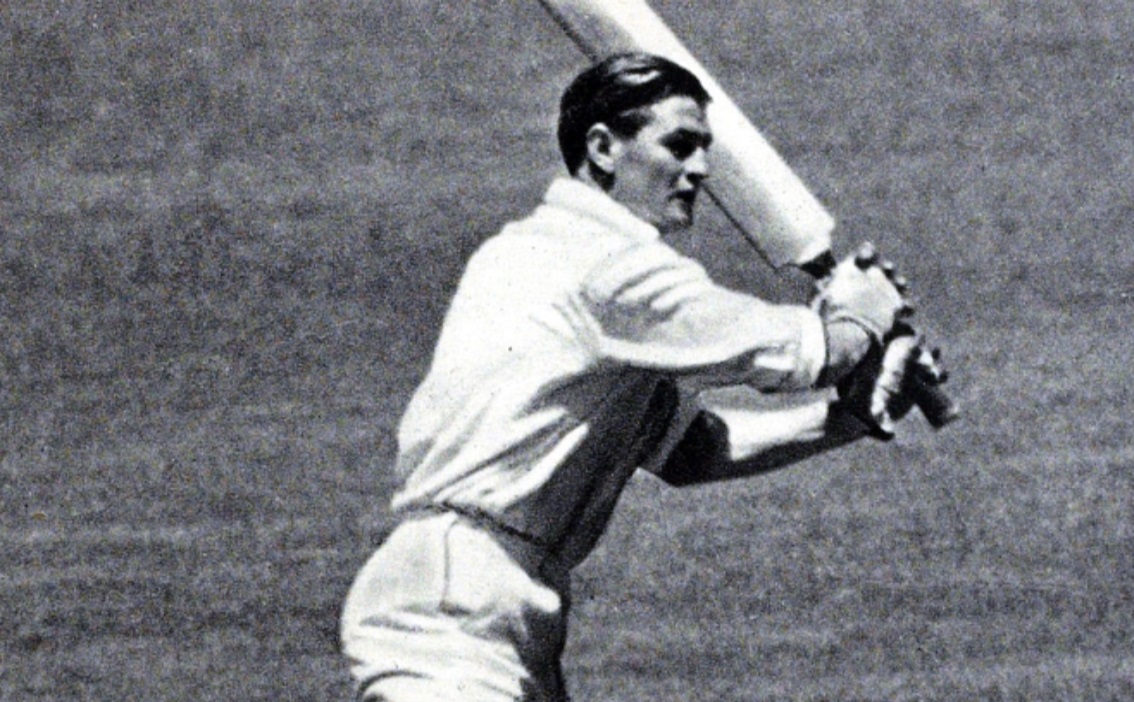
Over 70 years ago in December 1950, my father took me to the Melbourne Cricket Ground to see my first Test match between Australia and England. Thus the beginning of a passion for the game of cricket.
I was captivated by Keith Miller, the great all-rounder, who was and remains one of the most outstanding players in the history of the game.
Sir Donald Bradman had not long retired and Lindsay Hassett was Captain and other key players were Arthur Morris, Neil Harvey and Ray Lindwall. England’s Captain was Freddie Brown and the team included Len Hutton, Denis Compton, Alec Bedser and Godfrey Evans.
Since that Test match I have been fortunate to attend over 160 Tests at all the major Test grounds in Australia, except the new ground in Perth. I have also seen Tests at all the major grounds in England and the Caribbean.
I have seen many exciting close finishes, and have selected seven matches from the many worthy of recalling. Although Australia was usually on the losing side, there is no doubt that cricket was the winner.
Australia v West Indies Melbourne Cricket Ground December 31, 1951 to January 3, 1952
John Goddard Captain of West Indies won the toss and decided to bat and batting number 3 Frank Worrell with 108 was the major contributor to the score of 272. The “Three W’s” Worrell, Everton Weekes and Clyde Walcott from Barbados were ranked with the best batsmen in the World. Keith Miller was amongst the wickets with 5 for 60.
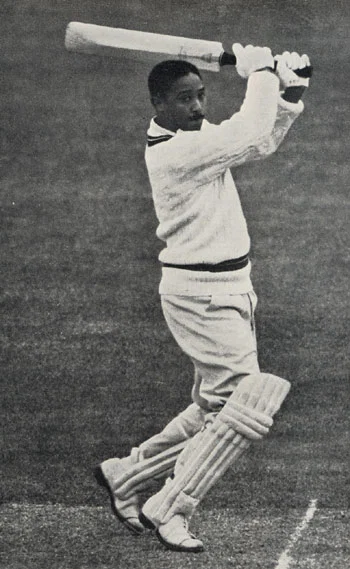
West Indies captain Frank Worrell
Australia struggled making 216, the highlight being a partnership of 124 between Neil Harvey 83 and Keith Miller 47. During this partnership an intriguing battle took place with the West Indies spin twins Alf Valentine left arm and the mystery spinner Sonny Ramadhin right arm.
In their second innings West Indies were held to 203 with Stollmeyer 54 and Christiani 52 being the main contributors. The wickets were shared by Ray Lindwall 3, Miller and Bill Johnston 2 each.
Australia were set 260 to win and again the spinners were on top with Valentine 5 and Ramadhin 3 wickets. They didn’t have express fast bowlers in those days. Lindsay Hassett held the innings together for 5 hours making 102. With the score 9 for 222, number 11 Bill Johnston joined his Richmond team mate Doug Ring requiring 38 runs to win.
The next 35 minutes had the crowd on the edge of their seats watching an amazing and exciting finish to the match. Doug Ring was a more than capable lower order batsman who liked to chance his arm with lusty blows over the infield. Bill Johnston, despite leading the batting averages on a tour of England, was regarded as a bunny. They soon had the West Indies in panic mode with dropped catches, misfields and mid pitch conferences involving a number of their players. However to no avail as the last pair held their nerve, with Johnston turning a ball to fine leg for the winning run for victory by one wicket.
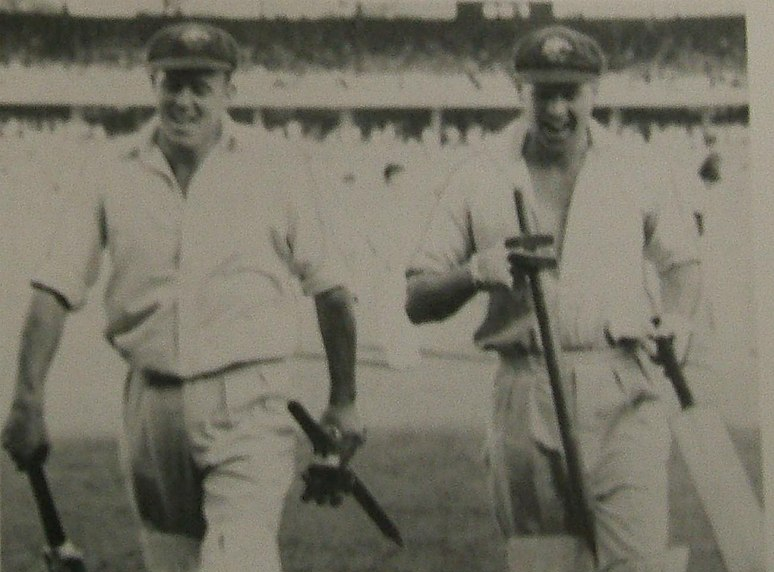
Bill Johnston and Doug Ring
Australia v England at MCG December 26 to 30, 1982
Greg Chappell won the toss and invited England captained by Bob Willis to bat. The scores throughout this match were very close continuing to the end.
England led by Chris Tavare 89 and Alan Lamb 83 were dismissed for 284. The wickets were shared by Rodney Hogg 4 for 69, Bruce Yardley 4 for 89 and Jeff Thomson 2 for49.
The Australian innings proceeded to 287 a lead of 3 runs. The best contributions came from Kim Hughes 66, David Hookes and Rod Marsh 53 each. Willis 3 for 38, Geoff Miller 3 for 44 and Norman Cowans 2 for 69 were amongst the wickets.
In its second innings England were dismissed for 294 with Fowler 65. Geoff Lawson 4 for 66, Hogg 3 for 64 and Thomson 3 for 74 shared the wickets.
The victory target was 291 and runs were proving difficult to get. A partnership of 100 between Hughes 48 and Hookes 68 took the score to 3 for 171, just 120 runs for victory. However wickets then fell rapidly due to an excellent spell from Cowans 6 for 77. The last man Jeff Thomson joined Allan Border late on the fourth day requiring 73 to win.
Play commenced on the 5th morning with Australia requiring 37 runs to win. The gates were thrown open to the public and about 30,000 people witnessed almost an hour of enthralling cricket.
The tension was almost unbearable and with Border on 62 and Thomson 21 and 4 runs required, Botham was brought on to bowl from the Outer end. Thomson tried to hit the first ball through the slip area, got an edge which flew to second slip. Tavare dropped the ball, only for Miller to dive and complete the catch and secure victory for England by 3 runs.
Australia v New Zealand at MCG December 26 to 30, 1987
As the result of this match was a draw, one can be excused for asking me why it could be one of the most exciting Tests that you have seen. My answer is that the match turned from a probable win for Australia to an almost certain win for New Zealand and finally an unlikely draw.
Allan Border won the toss and invited the New Zealand captain Jeff Crowe to bat and they made 317 with John Wright 99 and Martin Crowe 82 the main contributors. Craig McDermott 5 for 97 and Mike Whitney 4 for 92 were the wicket takers.
Australia then batted compiling 357 runs with Peter Sleep 90, Steve Waugh 55 and Tony Dodemaide 50 being the most successful. Richard Hadlee took 5 for 109 from 44 overs.
Thus Australia was set 246 to win. An even contribution from the batsmen followed with David Boon 54, Border 43 and Mike Veletta 39. The score was 5 for 209 when the wickets of Veletta and Sleep fell and suddenly with Hadlee at his menacing best, Australia was in danger of defeat.
With the score 9 for 227, there were 29 deliveries remaining and 19 runs required by Australia. Mike Whitney joined Craig McDermott. The atmosphere was electric with a win soon being put out of the question and the batsmen adopting a survival mode. Mike Whitney with a Test batting average of 6.18 was left to face the last over from Hadlee who already had 6 wickets and 11 for the match. Whitney defiantly played at and missed or defended each ball. After the last ball which he kept out of his stumps, he threw his bat onto the pitch, embraced McDermott to celebrate an exciting draw.
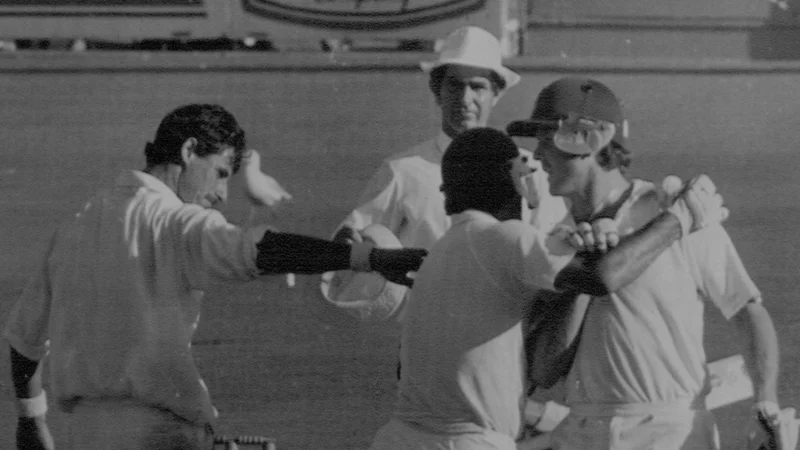
Australia v West Indies at Adelaide Oval January 23 to26,1993
This was a Test match where generally the bowlers had the better of the batsmen with runs being difficult to score. The result was other than a tie, as close as it can get with one run separating the teams at the end.
Ritchie Richardson won the toss and decided to bat, with the West Indies openers, Desmond Haynes and Phil Simmons, figuring on a partnership of 84 which was the highest of the match. Brian Lara with 52 was top score of the innings total of 252. Merv Hughes with 5 for 64 and Tim May 2 for 41 were the chief wicket takers.
Australia struggled in its first innings and Merv Hughes was top score making 43 of the 213 total. Curtley Ambrose with 6 for 74 was the best of the bowlers.
West Indies started its second innings with a lead of 39 and reached 5 for 137 with Ritchie Richardson making 72. The match then changed dramatically due to a brilliant spell of off spin bowling by Tim May who wrapped up the innings at 146 .May had figures of 5 for 9 from 6.5 overs.
Australia requiring 185 was soon in trouble. Justin Langer playing his first Test helped in a rescue mission making a very brave 54, supported by Mark Waugh 26. The rest of the top order failed due to the hostile bowling of Ambrose 10 wickets for the match, and also Walsh, Bishop and Benjamin.
Australia’s prospects seemed doomed when McDermott joined May at 9 for 144 requiring 41 runs to win. The Adelaide Oval was packed on Australia Day with the crowd becoming intensely nervous as the runs started to wear down the target. With two runs required to win, McDermott clipped a full length ball from Walsh which was stopped by the boot of the short leg fieldsman. Walsh then bowled a quick short one, which McDermott attempted to evade by swaying away only for the ball to clip the glove and be caught by the keeper Murray.
Victory to the West Indies saw exciting celebrations for their one run win and of course enormous disappointment for the Australians and the crowd. However it was a great privilege to be at the Adelaide Oval to witness one of the great Test matches.
Australia v South Africa at Sydney Cricket Ground January 2 to 6, 1994
Kepler Wessels won the toss and South Africa batted. With the exception of Gary Kirsten 67 and Hansie Cronje 41 the batsmen were dominated by Shane Warne with 7 for 56, and they were all out for 169.
Australia began with Michael Slater being again dismissed in the 90’s for 92. Useful contributions were made by Allan Border 49 and Damien Martyn 59 in the total of 292 a lead of 123. Chief wicket takers were Alan Donald 4 for83 and “Fanie” de Villiers 4 for 80.
South Africa batted again with difficulty due to Warne 5 for 72 and McDermott 4 for 62. Warne had achieved what appeared to be a match winning performance with figures of 12 for 128. South Africa finished with 239, top score Jonty Rhodes 76 not out, a lead of 116.
Australia started its second innings after tea on day 4 and were soon under pressure being 4 for 57 at stumps requiring 60 runs for victory.
The last day started under a very hot smoke haze with bush fires surrounding Sydney. The batsmen were soon under enormous pressure with the wicket playing lower and slower. McDermott came in after the fall of the 7th wicket and joined Martyn requiring 44 to win. However he almost immediately lost Martyn 6 who lost his nerve and attempted a big cover drive off McDonald resulting in an easy catch to Hudson. Martyn paid a heavy price for this dismissal as he was not selected in a Test match for some years.
McDermott took to the bowling, chancing his arm with some lusty blows and reached 29. May who had not scored was dismissed LBW quickly followed by McGrath, both to the bowling of deVilliers. Therefore another very close loss by Australia with South Africa winning by 5 runs. deVilliers was the destroyer with 6 for 43 and 10 for the match and Donald had figures of 3 for 34 and 7 for the match.
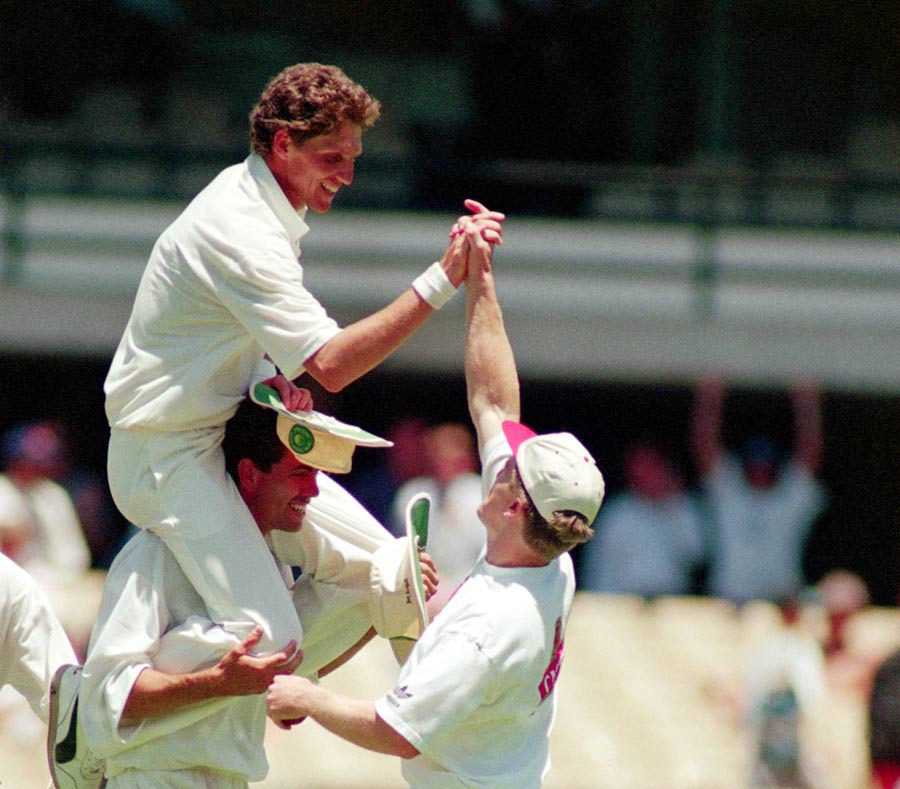
Fanie de Villiers hoisted high after South Africa beat Australia
West Indies v Australia at Kensington Oval, Bridgetown, Barbados March 26 to 30, 1999
Steve Waugh won the toss and decided to bat on a beautiful sunny Caribbean day before a colourful and enthusiastic crowd.
After a fairly nervous start Mark Waugh was bowled by Ambrose for a duck and the score was 3 for 36. Steve Waugh then joined Justin Langer and they took the score to 144 before Langer was bowled by Hooper for 51. Ricky Ponting then joined his captain and they figured in a brilliant 5th wicket partnership of 281 before he was dismissed for 104 with the score on 425. Ian Healy went without scoring and Steve Waugh missed a double century and was out for 199. The tail assembled another 60 runs before being all out for 490 shortly after tea. The wickets were shared by Curtly Ambrose 2, Courtney Walsh 2, Nehemiah Perry 3 and Carl Hooper 2.
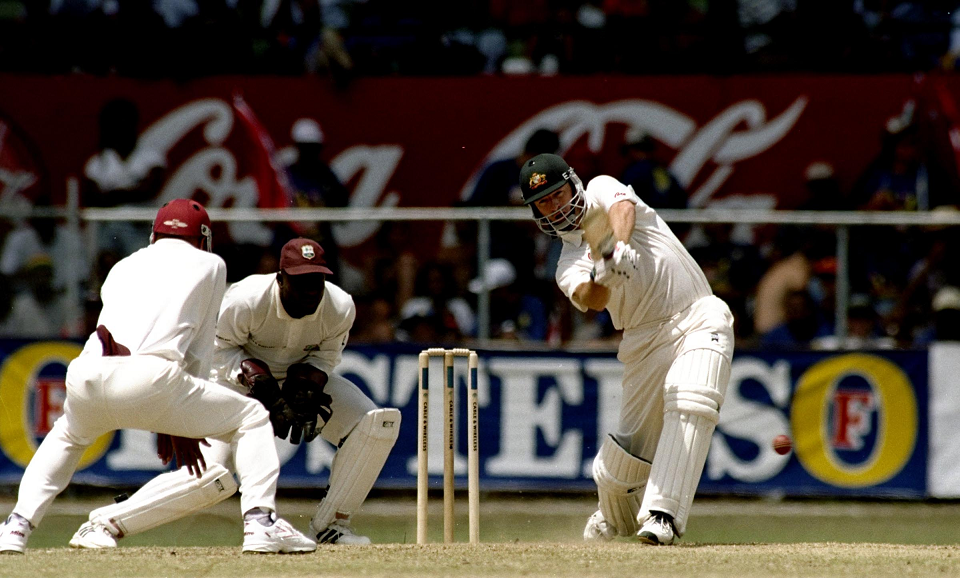
Steve Waugh on his way to 199 v West Indies
The Australian attack led by Glenn McGrath and Jason Gillespie was soon on top and with the exception of Sherwin Campbell who batted for more than a day for 106, the top order failed. With the score at 6 for 98 the wicket keeper Ridley Jacobs came to the crease making 68 and figuring in a partnership with Campbell which took the score to 7 for 251. The tailenders then hit out to take the final score to 329, which trailed Australia by 161. McGrath 4 for 128 and Gillespie 3 for 48 were the best bowlers.
Shane Warne’s only wicket was that of the last man Walsh and his figures were 1 for 70 from 15.5 overs. Warne did not get a wicket in the second innings and it was not surprising to me and a number of Australians at the match that he was dropped from the next Test at Antigua. It was obvious that he was not at his best as he was still recovering from shoulder surgery.
The Australian 2nd innings began just before stumps on day 3. Matthew Elliott went second ball for a duck caught behind off Walsh and Langer followed soon after for 1. At stumps the score was 2 for 18 with Gillespie in as a night watchman.
Day 4 did not bring much joy for the batsmen, the highest score being Warne with 32 in a total of 146, and the West Indies were set a target of 308.
At stumps on day 4, the West Indies were 3 for 85 with Brian Lara on 2. The 5th and last day of the match brought one of the most memorable in Test history. When Hooper was caught behind off Gillespie the score was 5 for 105.
However Jimmy Adams joined Lara and defended patiently for almost 3 hours making 38 in a partnership of 133, in which Lara was brilliant, displaying his full range of strokes. With the score on 8 for 248 Ambrose joined Lara contributing 12 while Lara continued his dashing display. With 6 runs required Ambrose was caught in the gully by Elliott off the bowling of Gillespie then 9 for 302. Courtney Walsh then strode to the crease and more drama, when Lara was dropped behind by Healy. Both McGrath 5 for 92 and Gillespie 3 for 62 had bowled valiantly with little support from the spinners. However in their defence they were bowling to one of the great batsmen in Brian Lara at the peak of his powers. With one run or one wicket required for victory Lara cover drove Gillespie for 4 to achieve a magnificent win for the West Indies, against the odds, by one wicket. Lara finished on a magnificent match winning 153 not out. In all the years that I have watched Test cricket I have not seen a better or more entertaining player than Brian Lara. I was fortunate to see him make 6 of his 9 centuries against Australia.
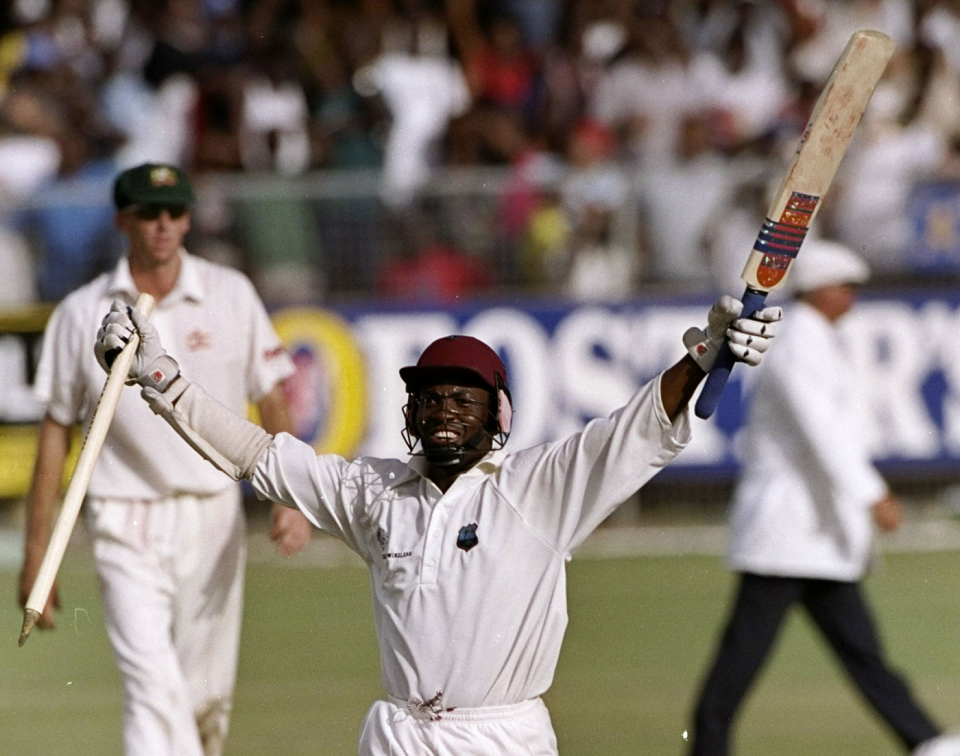
Brian Lara match winning innings secures victory for West Indies
England v Australia, Edgbaston, Birmingham, August 4 to 7, 2005
Australia went into this Test match extremely confident, after a convincing win in the previous Test at Lord’s. However all was not well as in the warm up, Glenn McGrath stood on a ball injuring his ankle and he had to be replaced in the team by Michael Kasprowicz. Given this set back it was a great surprise when Ricky Ponting won the toss and put England in to bat. England quickly took the initiative and on that first day they mauled the Australian bowlers making 407 at over 5 runs an over. In that total there were 10, 6’s and 54, 4’s. The top scorers were Marcus Trescothick 90, Andrew Strauss 48, Kevin Pietersen 71 and Andrew Flintoff 68 including 5, 6’s. The wickets were shared by Shane Warne 4 for 116, Kasprowicz 3 for 80, Jason Gillespie 2 for 91 and Brett Lee 1 for111.
Australia’s innings got away to a bad start with Matthew Hayden out from the first ball he faced. Ricky Ponting joined Justin Langer and batted in full control for 61, when he was surprisingly dismissed at 2 for 88. Langer held the innings together for over 4 hours for 82 and he was given support by Michael Clarke 40 and Adam Gilchrist 49 not out, in the total of 308, 99 runs in arrears. England’s most successful bowlers were Flintoff 3 for 52, Ashley Giles 3 for78 and Simon Jones 2 for 69.
England batted again towards the end of the day’s play and Shane Warne bowling from the city end produced a brilliant ball pitching 2 feet outside off stump and bowled Strauss without him offering a shot.
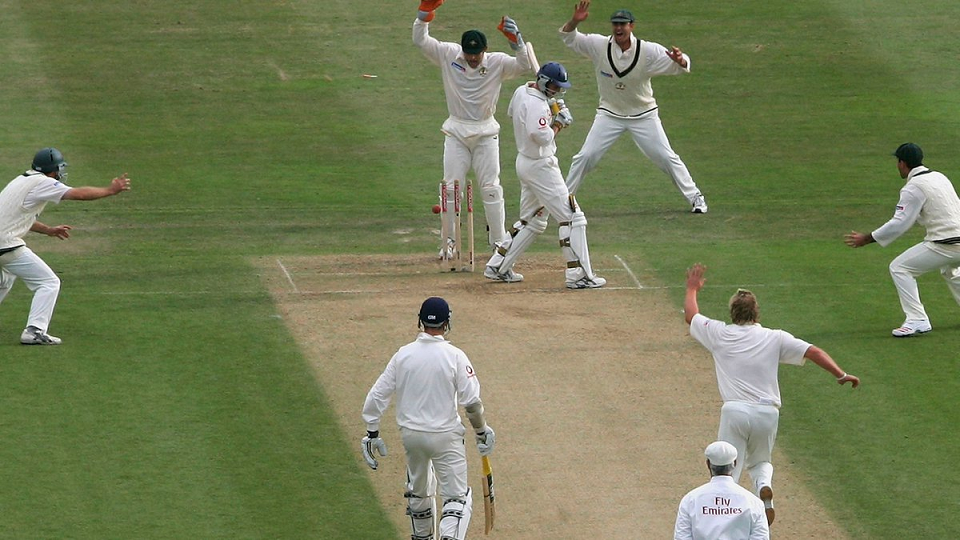
Shane Warne bowls Andrew Strauss
On the third day England was kept under enormous pressure due to the magnificent bowling of Warne who took 6 for 46 from 23.1 overs, giving him 10 wickets for the match. He was ably supported by Brett Lee who bowled with his usual hostile pace and took 4 for 82. Flintoff was the only batsman to offer resistance with 73 including 4, 6’s in the total of 182.
Australia started its second innings requiring 282 runs to win. After an opening partnership of 47 between Langer and Hayden, Australia was soon under continuous assault from England, with Flintoff being more than difficult to handle. When Michael Clarke was bowled by a Yorker from Harmison on the last ball of the day for 30, with the score 8 for 175, the Test seemed all but over.
The last day began with Australia requiring 107 to reach the target of 282, with two wickets in hand. Brett Lee joined Shane Warne on 20.They showed great fighting spirit and the further play progressed and the runs started to flow, the more in control they became. However when Warne trod on his wicket bowled Flintoff for 42, the score was 9 for 220, leaving 62 runs required.
Michael Kasprowicz joined Lee and over the next hour the runs continued to accumulate. The mood changed with the England players and their supporters and for a brief time it seemed that Australia would pull off an amazing win. With 4 runs required Lee square cut Harmison and the ball went like a bullet towards the point boundary only to go straight to the fieldsman. A yard or two either side it was four. Kasprowicz then took strike with 3 runs required for an Australian win. Harmison bowled a short ball which Kasprowicz tried to avoid. However it hit his glove and was caught by the wicket keeper Jones and was given out by Umpire Bowden. England had won a magnificent Test match by 2 runs.
There was the contrast of the jubilation of the England players and supporters and Australia’s devastation. A lasting memory was the sportsmanship of “Freddie“ Flintoff who went to Brett Lee and consoled Brett by putting his arm around him during the celebrations.

Andrew Flintoff and Brett Lee








